Standards Worldwide
Standards Worldwide
Phone +49 30 58885700-07

Standard [CURRENT]
ASTM G 99:2023
Standard Test Method for Wear and Friction Testing with a Pin-on-Disk or Ball-on-Disk Apparatus
- German title
- Verfahren für eine Verschleißprüfung mit einer Stift-Scheibe-Vorrichtung
- Publication date
- 2023
- Original language
- English
- Pages
- 6
- Publication date
- 2023
- Original language
- English
- Pages
- 6
- DOI
- https://dx.doi.org/10.1520/G0099-23
Product information on this site:
Quick delivery via download or delivery service
Buy securely with a credit card or pay upon receipt of invoice
All transactions are encrypted
Short description
1.1 This test method covers a laboratory procedure for determining the wear of materials and friction during sliding using a pin-on-disk apparatus. Materials are tested in pairs under nominally non-abrasive conditions. The principal areas of experimental attention in using this type of apparatus to measure wear are described. 1.2 This test method standard uses a specific set of test parameters (load, sliding speed, materials, etc.) that were then used in an interlaboratory study (ILS), the results of which are given here ( Tables 1 and 2 ). (This satisfies the ASTM form in that "The directions for performing the test should include all of the essential details as to apparatus, test specimen, procedure, and calculations needed to achieve satisfactory precision and bias.") Any user should report that they "followed the requirements of ASTM G99 ," where that is true. 1.3 Now it is often found in practice that users may follow all instructions given here, but choose other test parameters, such as load, speed, materials, environment, etc., and thereby obtain different test results. Such a use of this standard is encouraged as a means to improve wear testing methodology. However, it must be clearly stated in any report that, while the directions and protocol in Test Method G99 were followed (if true), the choices of test parameters were different from Test Method G99 values, and the test results were therefore also different from the Test Method G99 results. This use should be described as having "followed the procedure of ASTM G99 ." All test parameters that were used in such case must be stated. 1.4 The values stated in SI units are to be regarded as standard. No other units of measurement are included in this standard. 1.5 This standard does not purport to address all of the safety concerns, if any, associated with its use. It is the responsibility of the user of this standard to establish appropriate safety, health, and environmental practices and determine the applicability of regulatory limitations prior to use. 1.6 This international standard was developed in accordance with internationally recognized principles on standardization established in the Decision on Principles for the Development of International Standards, Guides and Recommendations issued by the World Trade Organization Technical Barriers to Trade (TBT) Committee.
ICS
17.040.20
DOI
https://dx.doi.org/10.1520/G0099-23
Also available in
Loading recommended items...
Loading recommended items...
Loading recommended items...
